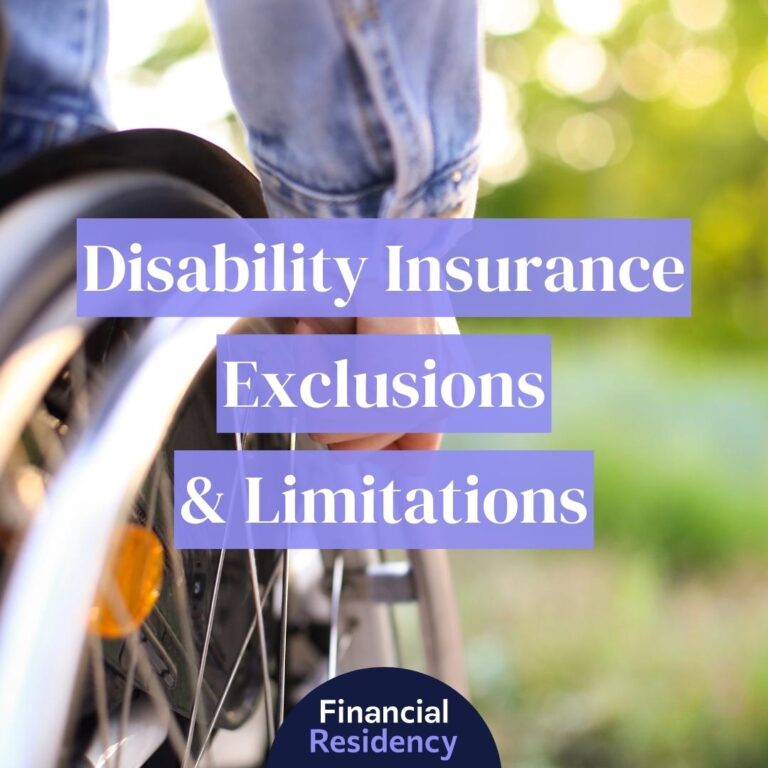Purchasing disability insurance is the key to protecting your income as a doctor, but you have many options. Own occupation disability insurance is the cream of the crop when choosing a disability policy.
Here’s everything you must know about it.
What Is Own Occupation Disability Insurance?
Own occupation disability insurance offers the broadest coverage. For example, if you become disabled but could work another position, just not your most recent one, you can get a payout.
This means you may not be so disabled that you can’t do anything, but you’re unable to do the job you went to medical school for.
Own occupation disability insurance is the most desirable, especially for highly paid medical professionals who couldn’t make the same income at another job if they couldn’t perform their current duties.
Own occupation disability insurance usually costs more than other forms of disability insurance, but it offers the most income protection.
Types of Own Occupation Disability Insurance Policies
Like most insurance policies, there are different types of own occupation insurance policies.
Some consider them ‘loopholes’ to get out of long-term benefits. Always know the terms and read the fine print before purchasing a policy.
True Own Occupation
True own occupation means you cannot work the exact duties of your current position due to your disability, even if you can work another job.
With most policies, you can work another job but get disability coverage to make up for the income you’re not making by being unable to work the higher-paying position.
Each policy has different requirements, so read the fine print. For example, some make the coverage broader, stating you can file a claim if you can’t work any position in your field (medicine), while others payout if you can’t work your specific position, even if you can work in the medical field.
Transitional Own Occupation
Transitional own occupation coverage is a variation of traditional own occupation coverage and pertains to those professionals that work another job while disabled.
This policy usually makes up the difference between the earnings at your new position and the maximum benefit. However, some policies may pay the difference between your pre-disability income and post-disability income, but again, up to the maximum benefit.
For example, if you were a surgeon earning $20,000 a month but lost the use of your left arm, you can’t work as a surgeon any longer. After six months, you begin working as a professor, making $6,000 a month, and have a $ 10,000-a-month disability policy.
Transitional own occupation coverage would make up the difference between the $10,000 benefit and $6,000 earnings, paying you $4,000 a month.
Modified Own Occupation
Modified own occupation coverage only pays you if you don’t work; this includes any job. Another common name for it is own occupation, not working.
So if you become disabled and can’t perform your position but take another job, even in an unrelated industry, you wouldn’t receive a payout.
Medical Specialty Own Occupation
Medical specialty own occupation insurance is coverage with many limitations. It narrows your coverage down to not only specific occupations but also specific duties.
If you purchase this policy early in your career and your responsibilities evolve, they may fall outside the coverage, leaving you without a payout if you become disabled.
It’s usually best to stick with a broader own occupation policy to ensure you’re covered.
Own Occupation vs. Any Occupation
Many own occupation policies have an occupation provision or transfer to any occupation after a specific benefit period.
For example, the surgeon who lost the use of his arm has his own occupation coverage for a few years, but then when they expire, it turns into any occupation. If the surgeon decides not to work somewhere despite being able to, he won’t receive any benefits.
This type of policy protects you for a short time, allowing you time to heal from your disability, but then expects that you’ll work another position, even if lower paying, after a while.
This is common for group disability insurance policies, but some individual policies have the same terms.
Why Own Occupation Insurance Is Important for Physicians
Doctors are great candidates for own occupation disability insurance because they are highly paid professionals.
But, unfortunately, most positions they could get after becoming disabled won’t pay nearly as much as they’re used to earning.
You made a significant investment in medical school both monetarily and with time. Not seeing the return on investment because you’re disabled could be detrimental mentally and financially.
True own occupation insurance protects your income even if you can work another job with lower pay. Some professionals can’t work and may consider a transitional occupation rider to protect their income level while still being able to occupy their minds.
Own Occupation Disability Insurance Considerations
Just like any insurance policy, certain factors should be considered when choosing a disability insurance policy.
Cost
Insurance policies have premiums, so it’s like an investment in yourself and you might wonder if disability insurance is worth it. Before accepting a policy, not only should you look at the coverage but also the cost. Ensure it fits within your budget and makes sense, given the coverage you’ll receive.
Many factors affect the cost, including the benefit period and amount, the elimination period, and any provisions you add.
Benefit Period
The benefit period states how long you can receive benefits if you become disabled. Even though they are long-term disability policies, it doesn’t mean they will pay benefits for your lifetime, always read the fine print.
Some pay for a few years, while others pay until you hit retirement age, which some policies make 65 to 67 years old.
Elimination Period
The elimination period states how long you must wait to receive payment after becoming disabled. The longer you must wait for coverage, the lower your premiums. However, you must have enough money to cover your living cost for that time.
For example, if you have a 6-month waiting period, you must have six months of expenses set aside to cover the cost of living until your benefits begin.
Benefit Amount
Most insurance companies limit your benefit to 60% of your income, but some may allow as much as 80% coverage. Unfortunately, you won’t find companies paying 100% of your income.
The more coverage you need, the more you’ll pay in premiums. When choosing your benefit amount, consider all sources of disability income, including group disability insurance policies. They may not be enough to cover your cost of living, but any amount you can decrease your individual disability insurance lowers your premiums.
Provisions
You may also be able to add provisions or riders to your policy to provide extra protection against the unknown.
Here are a few to consider.
- COLA Adjustment – This rider allows insurance companies to increase your benefit while you are disabled if inflation rates rise. This ensures you can keep pace with inflation and don’t struggle financially because the cost-of-living-increased since you purchased your policy.
- Guaranteed Renewability – This provision ensures the insurance company will not cancel your policy throughout its term as long as you make the premiums. This doesn’t, however, guarantee the premiums won’t increase. You just have the guarantee of coverage.
- Non-Cancelable Provision – The non-cancelable provision ensures the insurance company cannot increase your premiums throughout the term. So no matter how much inflation increases or insurance rates change, your premiums remain the same as long as you pay your premiums.
- Future Increase Option – If you purchase your policy early in your career, you will likely earn more as you advance. Your initial insurance policy may not cover enough, but the future increase option allows you to increase coverage annually without additional underwriting or hoops to jump through.
- Portability – Group disability insurance ends when you change jobs, which can be a downside for medical professionals. Policies with portability, though, go with you no matter how many times you change jobs.
- Specialty Riders – A few specialty riders you may consider include:
- Student loan protection rider – If you become disabled early in your career, this rider can help cover your student loan payments without removing your original benefit to cover the cost of living.
- Partial disability rider – If you aren’t fully disabled and can only perform some duties of your current position or must work fewer hours, partial disability may make up the difference in what you cannot earn.
Lookout for Loopholes
Many disability insurance policies include loopholes that, if you aren’t aware of them, can leave you without the benefits you thought you’d have. Here are some common areas to watch.
Limited Benefits
If your policy offers residual benefits, which pay you the difference between your pre-disability pay and post-disability pay, there may be a provision for limited benefits or restrictions on how/when you can get the benefits.
For example, a policy might say you must be disabled for X number of months before you can claim residual benefits. However, not everyone goes from perfectly capable to 100% disabled overnight, especially people with progressive diseases. So if you slowly downgrade to a more manageable position but never stop working, you could lose disability benefits.
Modified Language and Terminology
Some own occupation policies have such restrictive language that the policy isn’t truly ‘own occupation.’ Instead, they state that you must not be able to do ANY tasks of your current position to earn a payout.
For example, if you were a dental surgeon but hurt your hand and cannot perform surgery but can be in the office, doing consultations and other minor tasks, the insurance company could get around paying you benefits even though you aren’t earning nearly as much.
Transitioning to Any Occupation
Many own occupation policies transition to any occupation after a certain benefit period. Some are as short as two years, so know the limits before purchasing a policy. It may not be worth the higher premiums if your benefits only last a few years.
How to Get Own Occupation Disability Coverage
Doctors and medical professionals usually have two ways to secure their own occupation disability insurance. You can secure it through your employer or purchase an individual policy.
Through your employer, you may have group disability insurance. Some employers only offer short-term disability, but others provide long-term. If they do, it may be own occupation disability coverage, or you may be able to purchase a rider to make it own occupation.
Group disability insurance often has lower premiums, and your employer may even cover a portion of the cost, if not all of it. However, this makes your benefits taxable, so account for that when determining how much coverage you have.
If you don’t have group coverage, or it’s insufficient, you can purchase own occupation disability coverage privately. This option is more expensive, but you can customize it to your needs.
In addition, the benefits are tax-free since you pay the premiums with after-tax dollars, and you won’t lose coverage if you change jobs since your employer does not sponsor it.
Pros and Cons of Own Occupation Disability Insurance
All insurance policies have pros and cons, including own occupation disability insurance. Here’s what to consider.
Pros
- Higher chance of payout – If you become disabled, you have a greater chance of getting a payout even if you can work another position, as long as the policy doesn’t have transitional benefits or for at least as long as the initial benefit period.
- Higher payouts – If you purchase an individual policy, you may cover a larger percentage of your income, protecting yourself should the worst happen.
- Many variations – Even if you can or do work to a lesser degree, many own occupation policies have riders that pay residual benefits to make up for the lower income.
Cons
- High premiums – Own occupation disability insurance usually has much higher premiums than any occupation policies because of the risk insurance companies take with highly paid professionals.
- Fine print – Many policies have fine print that makes the policy not 100% own occupation coverage. There are often loopholes in letting them out of paying coverage long-term.
FAQs
Own occupation disability insurance is the key to protecting high-income doctors’ pay. Here are some commonly asked questions about the coverage.
How Long Is an Own-Occupation Policy Good For?
Every insurance policy differs. Some provide benefits through retirement (65 to 67), while others have a specified term, such as 2 to 5 years. It depends on the policy you purchase and the type of disability. For example, mental health or nervous system disabilities may have a much more limited payout period than other disabilities.
Is Own Occupation Disability Insurance Ever a Bad Choice for Physicians?
Own occupation disability insurance isn’t a bad decision for doctors unless the premium is so high that it’s hard to afford. It may be more affordable if you purchase the policy early in your career and purchase a future increase option.
Is Disability Insurance Income-Based?
Yes, disability insurance coverage depends on your income. The more you make, the more coverage you can get, but on average, insurers pay 60% of a doctor’s income.
Do You Need Own Occupation Disability Insurance?
Own occupation disability insurance may provide the maximum coverage needed should you become disabled. However, every insurance policy has loopholes and factors to consider.
Look at your options and read the fine print to ensure the coverage is right for you.



